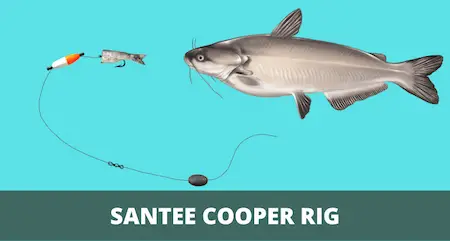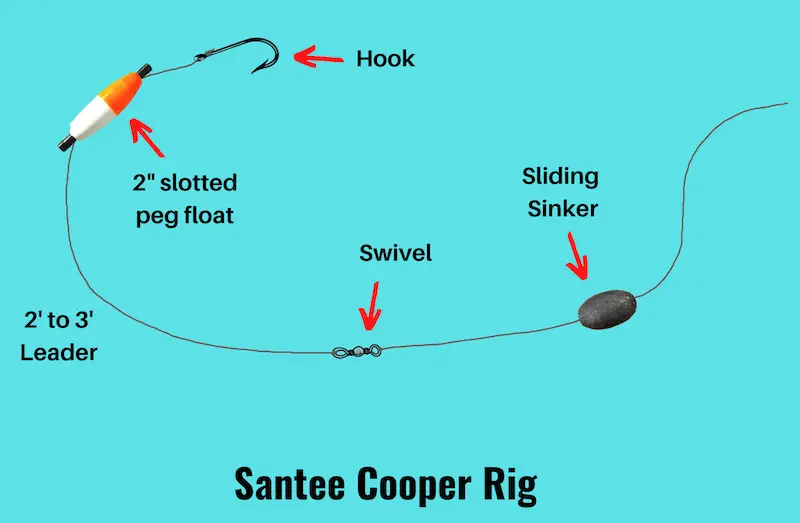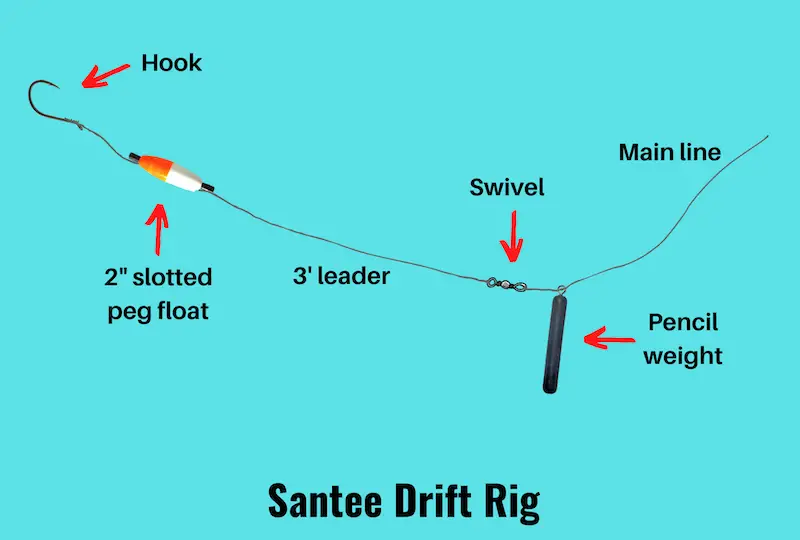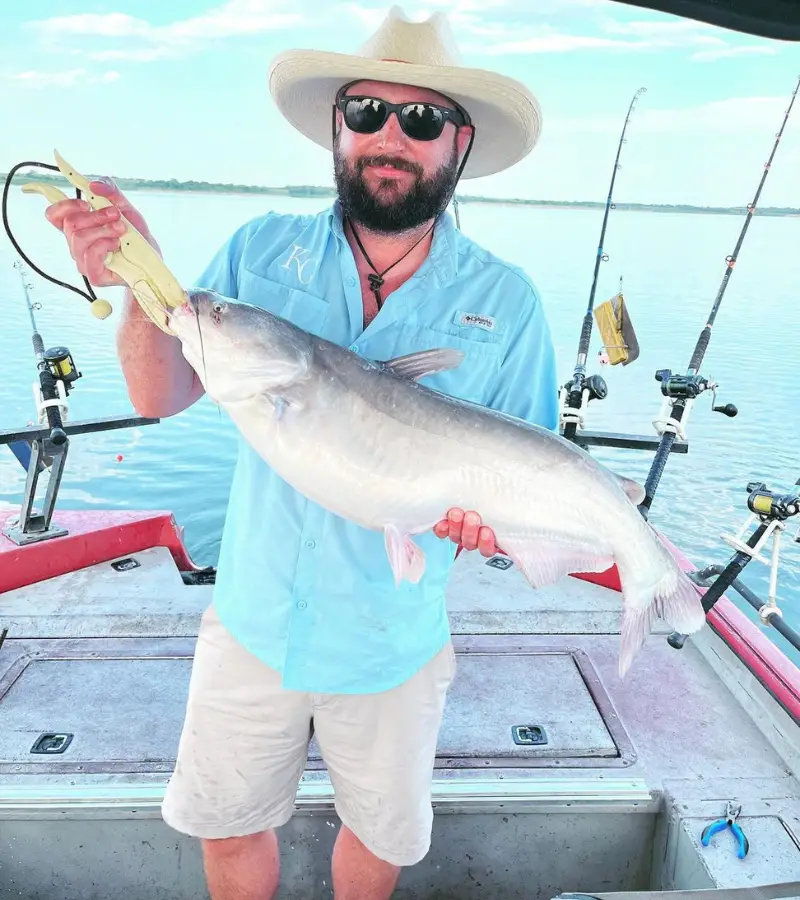Santee Cooper Rig (Setup and Fishing Guide with Pictures)
PUBLISHED 16 AUGUST 2023
by Robert Ceran
Are you planning to throw a Santee Cooper rig, but aren’t sure how to set it up, or how to fish it for optimal results?
While the Santee rig is without a doubt one of the most effective and popular catfish rigs, it can be tricky to set up and to fish it for the best results.
In this article I’ll show you how to set up a Santee Cooper rig, and will aso cover what bait to use with it, and how to use it to put more catfish in your boat.

What is a Santee Cooper rig (and what is it good for)?
A Santee Cooper rig is a catfish bottom rig that consists of a sliding sinker, a swivel, and a leader with a small peg float rigged next to the hook, to keep the bait off the bottom.
This rig got its name from the Santee Cooper lake system in South Carolina, which is famous for its excellent catfish fishing (claimed by some to be the best in North America).
The Santee Cooper catfish rig was developed by local catfish anglers who discovered that it works better for avoiding snags when drift fishing for catfish, especially over a weedy bottom.

The Santee rig is basically a modified version of the slip sinker rig, and comes with a 2 inch peg float that is added to the leader. The peg float lifts the baited hook up in the water column, which avoids snags and makes it easier for catfish to find the bait when the bottom is weedy.
In my experience, when fishing a standard slip sinker rig next to a Santee Cooper rig, and using the same bait, I’ll get 2 to 3 times more bites on the rod with the Santee rig, which shows the superiority of this catfish rig.
The Santee Cooper rig catches all types of catfish in North America, including blue catfish, channel catfish, and flathead catfish. It can be fished statically from the shore or from an anchored boat, or it can be used for drift fishing for catfish.
And while the Santee rig was specifically developed for catfishing, it can also be used for other fish species that feed near the bottom, including carp, walleye, and trout.
Santee Cooper rig components
Below are the tackle components you’ll need for your Santee Cooper rig setup:
- 2” peg float
- 40 to 50 lb test leader (monofilament or fluorocarbon)
- Size 1/0 to #3 hook (circle hook or octopus hook)
- Barrel swivel
- 1 to 3 oz Sliding sinker (egg sinker, no roll sinker, or sinker slide)
- Plastic bead (optional)
Note that the size of the hook depends on the size of your bait, and the size of catfish that you’re targeting. In general, a size 2 or 3 hook is ideal for channel catfish, while a size 1/0 is better for flatheads and blue catfish.
I like to use braid as my main fishing line, as it has a smaller diameter, and allows me to spool more line onto the reel. However, you can also use monofilament as your main line, if that’s your preference.

A 2 to 3 ounce sliding sinker is generally heavy enough for most freshwater applications, and if there is no current you can even go as light as 1 ounce.
The plastic bead can be helpful when rigged between the sinker and the swivel, as it protects the knot on the swivel from being damaged by getting stuck inside the sinker.
However, this is not absolutely necessary, and personally I prefer to use a high quality sliding sinker that comes with polished edges and doesn’t damage your line.
How to tie a Santee Cooper rig
Start by tying the leader line to the hook with a snell knot (you can also use a palomar or uni knot, but a snell knot is stronger).
Then measure out 1 to 4 feet of leader line, cut it off, and attach the tag end to the barrel swivel. The length of your leader line determines how far above the bottom your bait will be presented (more on that below).
Next, thread your main fishing line through the sliding sinker, and then tie the line to the other eye of the barrel swivel.
In the final step, peg a 2 inch slotted peg float to the leader line about 1 to 2 inches above the hook.
If you’re using a slotted float (which I recommend), you can add it or remove it after the rest of the rig is already tied. But if you’re using a float without a slot, you’ll have to thread it onto the leader before tying on the hook.
The beauty of using a slotted float is that it allows you to easily turn a regular slip sinker rig (or a Carolina bottom rig) into a Santee Cooper rig, and vice versa.
A popular variant of the Santee rig is made with a pencil weight, slinky weight, or other type of no-snagg sinker instead of an egg sinker (see image below).

This variant is called a Santee drift rig, and the use of a no-snag sinker makes this presentation ideal for drift fishing or trolling for catfish. The Santee drift rig is similar to the Lindy trolling rig, which is primarily used by walleye anglers.
If you’re using the Santee Cooper catfish rig for drift fishing, it’s essential to use a no-snag sinker, as an egg sinker is more likely to get snagged on cover.
Choosing the right leader length
As a rule of thumb, start with a leader length of 1.5 to 2 feet (18 to 24 inches) for your Santee catfish rig, and then adjust it from there.
If you’re fishing in a lake with a weedy bottom, make sure that your leader is long enough to allow the bait to float above the plants. This may require increasing the leader length to 3 or 4 feet, which you’ll have to figure out by testing.
What bait should you use with a Santee rig?
You can use either cut bait or live bait with a Santee rig. Personally, I prefer to use cut fish, but some of my buddies swear by chicken liver.
When it comes to choosing the ideal fish to use for cut bait, fresh gizzard shad or herring are great options, as they produce plenty of scents in the water when they are fresh cut. If you can get live shad, these also make excellent live bait to use with this catfish rig.
How to fish a Santee rig for catfish
The easiest way to fish a Santee rig is to bait the hook, cast it out to a promising location, and then wait for bites.
You can use this approach either when fishing the Santee Cooper rig from the bank or from an anchored boat.

Image source: instagram/@ifnickhadinsta
But always keep in mind that if you’re fishing in a lake with a weedy bottom, your leader needs to be long enough so that the bait won’t be hidden inside the vegetation. If you’re not getting bites, try lengthening the leader.
Drift fishing with a Santee catfish rig
Drift fishing with a Santee Cooper drift rig is one of the most effective ways to catch catfish, period. If you go fishing with a guide on one of the Santee Cooper lakes, you’ll find that 99% of them use drift fishing with this catfish rig, and with great results.
The awesome thing about the Santee Cooper drift rig is that the hook is presented well above the bottom and thus doesn’t get snagged very often.
The only part of the rig that makes regular contact with the bottom is the sinker. And by using a pencil weight or another type of no-snagg sinker, you can minimize the snags, while maximizing the hookups with catfish.
Dragging a Santee drift rig along the bottom (either by drifting or trolling) enables you to cover a lot of ground in search of hungry catfish, which dramatically improves your chances of catching a cat or two.
